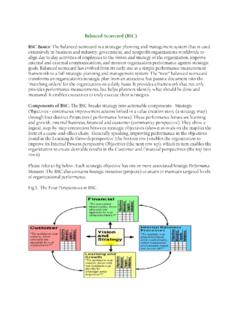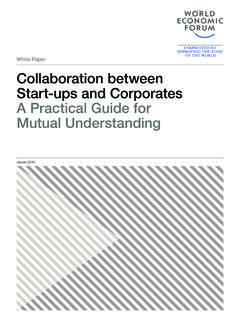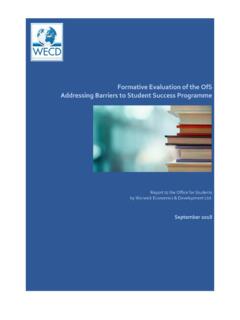Transcription of BLENDED FINANCE AND ACHIEVING THE SUSTAINABLE …
1 TRI HITA KARANA ROADMAP FOR BLENDED FINANCE . BLENDED FINANCE AND ACHIEVING THE SUSTAINABLE DEVELOPMENT GOALS (SDGs). BLENDED FINANCE is emerging as an important tool to help mobilise private financing towards the SDGs. BLENDED FINANCE is the use of development FINANCE to primarily crowd-in additional commercial FINANCE that is not currently deployed to support development outcomes, thereby growing the SUSTAINABLE development pie1. BLENDED FINANCE has gained a lot of momentum as a result of multiple stakeholder efforts, most recently in the G72. To capitalise on the collective strength in mobilising commercial capital towards the SDG-related financing gap, BLENDED FINANCE actors are engaging in a coordinated effort to ensure the effectiveness and scaling up of BLENDED FINANCE operations.
2 Approaches to BLENDED FINANCE have evolved over different periods of time at varying speeds and in response to diverse actors and stakeholders. These diverse approaches have resulted in the need for effective coordination, in order for improved outcomes for the broader BLENDED FINANCE agenda and development impact. To address this, a multi-stakeholder endeavour, bringing together different perspectives, has sought to develop a narrative for a shared BLENDED FINANCE value system and contribute towards effective coordination. An outcome greater than the sum of the parts is the aim, as well as inviting a broader group of stakeholders into the discussion. The goal is to work together, in parallel with the innovative and evolving investment environment, in order that the 2030 agenda can be effectively delivered.
3 Beyond scaling up commercial investments in the development FINANCE spectrum, BLENDED FINANCE providers and recipients must collectively champion the application of high standards and shared values throughout the financing process. BLENDED FINANCE stakeholders acknowledge that exploiting the potential of BLENDED FINANCE for the 2030 agenda cannot be achieved by a single organisation or country. In recognition of the need for a multilateral framework for delivering BLENDED FINANCE , multilateral actors, in this case the G7, have responded with requests for coordination, in order to widen engagement further. In line with the multi-stakeholder nature of BLENDED FINANCE , the roadmap below is being developed in order to further inform international agendas such as the G20 and UN.
4 We consider that only then will the full spectrum of actors be effectively coordinated towards SDG delivery. SHARED VALUES FOR ENSURING EFFECTIVE BLENDED FINANCE . 1. The OECD has framed BLENDED FINANCE as the strategic use of development FINANCE for the mobilisation of additional FINANCE towards SUSTAINABLE development in developing countries. The roadmap is directed to any form of BLENDED FINANCE in line with the OECD definition, concessionality is not a pre-requisite for blending. The MDBs and European DFIs working on private sector operations focus on BLENDED FINANCE that has a concessional element. Though this definitional difference is important when gathering, analysing and presenting data, the roadmap links these two efforts through core common values that underpin both the policy level OECD BLENDED FINANCE Principles and the operational level DFI.
5 Enhanced Principles for BLENDED Concessional FINANCE in Private Sector Operations. 2 For more information, please see chairs-summary-g7-joint-development-fina nce-ministers-meeting/. The Shared Value System on BLENDED FINANCE The shared value system on BLENDED FINANCE promotes that stakeholders act coherently within established and existing BLENDED FINANCE frameworks by finding a common language. Having a common language will reinforce actions both at the policy level as well as at the operational level. In doing so, the common value system will work as a means to building on existing governance mechanisms within a value driven framework. The shared value system aims to set a framework for common values for all actors working to scale their BLENDED FINANCE operations and improve their effectiveness.
6 As the BLENDED FINANCE market grows larger in terms of actors and activities, and as new stakeholder such as philanthropic and private sector actors enter the market, the common value system can provide guidance on the terms of references to those operating in the market. As a result, a shared value system not only enables improved engagement with the private sector, but it can ultimately drive alignment and greater efficiency in the market. 1. Anchor BLENDED FINANCE into the SUSTAINABLE Development Goals (SDGs). BLENDED FINANCE activities should support developing countries in ACHIEVING inclusive, social, economic and environmentally SUSTAINABLE development that benefits women and girls equally.
7 BLENDED FINANCE should aim to go beyond what is available, or which is otherwise absent from the market, and should not crowd out commercial FINANCE . 2. Commit to using BLENDED FINANCE to mobilise commercial FINANCE BLENDED FINANCE should operate as a channel for commercial capital to address SUSTAINABLE development. In doing so, BLENDED FINANCE operations should aim at scalability and leverage based on context and conditions. BLENDED FINANCE should assume a pathfinder role of bringing in commercial capital into sectors and jurisdictions where financing needs are the greatest, such as in LDCs and women's FINANCE , while balancing risks and rewards with minimum levels of concessionality.
8 3. Design BLENDED FINANCE to move towards commercial sustainability BLENDED FINANCE transactions should have a clear strategy for their duration and exit, in particular if concessional FINANCE is involved. That is, the level of concessionality extended to subsequent projects should not only aim at mobilising additional FINANCE , but also be reduced demonstrably over time. This includes that BLENDED FINANCE stakeholders should seek to actively locate pathways for financing private sector investments through market-clearing financing solutions. When blending with concessional FINANCE , the DFI Working Group Enhanced Principles on BLENDED Concessional FINANCE for Private Sector Projects3 (DFI Enhanced Principles) should be respected.
9 Suppliers of BLENDED FINANCE resources that can be utilised in a concessional manner can play a significant role in scaling up the effectiveness and efficiency of the BLENDED FINANCE market by actors respecting these DFI Enhanced Principles in all structures and initiatives to be funded with their concessional resources. 4. Structure BLENDED FINANCE to build inclusive markets BLENDED FINANCE should help to accelerate inclusive SUSTAINABLE market development, including the local financial market. Local engagement and ownership should be pursued. At the same time, BLENDED FINANCE should be accompanied by efforts to promote a sound enabling environment and investment climate. In addition, availability of information relevant for market making should be coordinated among policy makers, development FINANCE providers, commercial investors and investees to leverage experience and track record.
10 Ultimately, in each market, clarifying, sharing and addressing the root causes for requiring BLENDED financing should be prioritised. 5. Promote transparency when engaging in BLENDED FINANCE Accountability and transparency on the appropriate use and impact of BLENDED FINANCE should be pursued. Financial flows and development results should be tracked, reported and communicated. Thereby, BLENDED FINANCE should seek to promote adherence to high standards of conduct by private sector investors and investee companies, including in the areas of corporate governance, environmental impact, social inclusion, transparency, integrity, and disclosure4. 3 The DFI Working Group Enhance Principles can be accessed at 2304e962fc85/DFI+ BLENDED +Concessional+Fi nance+for+Private+Sector+Operations_Summ ary+.















